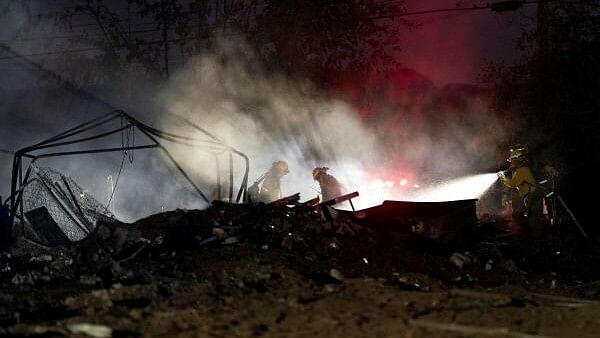
Firefighters work to extinguish hot spots in burned structures as the Boyles Fire burns in Clearlake, California.
Credit: Reuters Photo
An uncontrolled wildfire in Southern California threatened thousands of homes and businesses Sunday, after quadrupling in size Saturday to more than 17,000 acres and forcing mandatory evacuation orders for over 11,000 people.
As firefighters struggle to contain the blaze, known as the Line fire, in the foothills of the San Bernardino Mountains, they are dealing with a dangerous heat wave that is expected to affect Southern California and parts of the Southwest until at least Monday.
Christopher Prater, a firefighter and public information officer for San Bernardino County Fire, described a number of other challenges: thunderstorms that produced winds and "erratic fire behavior," drones apparently flown by civilians that forced firefighters to ground their aircraft more than once Saturday and resources stretched thin by the number of wildfires roaring across the Western United States.
Some of the problematic weather conditions were created by the fire itself.
"The fire itself helped spawn its own thunderstorms," said Dave Munyan, a meteorologist at the San Diego office of the National Weather Service. "Most of the aviation-based fire tactics had to be suspended yesterday due to the lightning."
The phenomenon is called a pyrocumulonimbus, or fire-generated storm. The blaze roaring across the earth's surface generates heat that rises into the air, Munyan said, and if enough moisture is present, generates a thunderstorm. Not only do such storms hamper firefighting but they can even cause new blazes by producing dry lightning.
The late-summer heat wave worsening the Line fire is raising the risk of more fires.
On Sunday, the region stretching from the Pacific coast to the mountains northwest of Los Angeles, including parts of Santa Barbara and Ventura counties, was under a red flag warning. That is the highest National Weather Service alert for conditions -- warm temperatures, low humidity and high winds -- that may result in extreme fire behavior.
The Line fire started Thursday in the city of Highland, east of Los Angeles, according to San Bernardino County officials and the California Department of Forestry and Fire Protection.
Fueled by soaring temperatures of over 100 degrees and "critically dry" vegetation, the fire spread rapidly Saturday toward the San Bernardino Mountains and grew from about 3,800 acres in the morning to more than 17,000 acres by Sunday, according to Cal Fire and the San Bernardino County Sheriff's Department.
As of Sunday morning, it was 0 per cent contained and threatened more than 35,000 structures, according to Cal Fire. The cause was under investigation.
"We saw really extreme fire activity and a really quick-moving fire" Saturday, said Brent Pascua, a Cal Fire spokesperson. "We're not going to get much help as far as the weather goes."
The number of structures threatened include homes and businesses in areas under evacuation orders and warnings, as well as some that could be affected if the fire -- which has behaved erratically over the past few days -- shifts, Prater said.
San Bernardino County and parts of Riverside County were under excessive heat warnings until Monday evening, the most serious heat alert. The weather service warned that daytime temperatures could reach 102 to 110 degrees, while the lowest night temperatures would fall only to the mid- to upper 70s.
More than 600 firefighters were trying to contain the blaze Sunday, but steep terrain and lack of access impaired their ability to reach some areas, Cal Fire said. Three firefighters have been injured, according to Cal Fire.
Glen MacDonald, a professor of geography at the University of California, Los Angeles, said that for all its ferocity, the Line fire is not a surprise. Two years of strong precipitation set off abundant growth of grasses and leafy shrubs. Then, a hot summer dried it all out, creating "just perfect fuel."
"All you need is an ignition source, and you're going to have a fire," he said.